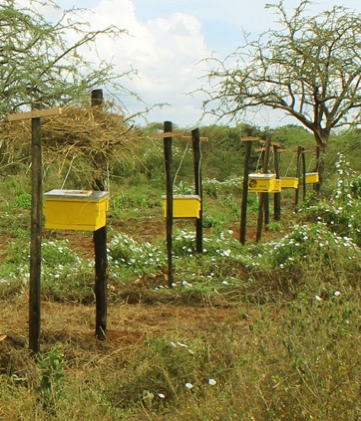The Elephants and Bees Project, Kenya

Summary
Implemented by Save the Elephants, the Elephant and Bees Project in the Taita Hills, Kenya, uses Beehive Fences as a natural elephant deterrent, helping protect farmers and farmland.
The solutions at the heart of The Elephant and Bees Project, based in Sagalla – Taita Hills, are replacing the solid physical barriers with unobstructed boundaries between farmers’ land and the surrounding environment, and at the same time creating a new source of income for communities.
The Taita area has been affected by changing rainfall patterns and severe droughts as a result of climate change, which drove agricultural expansion into protected areas, degrading indigenous forests and encroaching on wildlife habitats. Such conditions have worsened conflicts between elephants and people. The solution aimed at addressing this human-wild life conflict.
The idea is simple: elephants are repelled by the rumbling noise of bees in their natural environment. Setting up a series of beehives around the fields creates a soft barrier, preventing elephants from coming too close without needing to harm them. Experience through the project has shown that the presence of beehives drastically reduced the number of crop raids by 86 per cent. The number of elephants involved during the raids also decreased by over 50 per cent compared with a nearby farm without any protection. When spotted by the farmer, elephants inside the farm were not trapped or scared off by the beehive fence and could safely cross it to go away. At the end of the six-week study period, the farmer without any protection estimated a 90 per cent loss of harvest compared to the one who used the beehive fences.
Overview
- Location:
- Implementation sites:
-
- Single country
- Single location
- Mountain region:
-
Taita Hills
- Solution scale:
- Ecosystem type(s):
- Solution type(s):
- Climate impact(s) addressed:
- Other climate impact(s) addressed:
-
- human-wild life conflict
- Climate impact time-scale(s):
- Main benefit associated with the solution:
- Co-benefit(s) associated with the solution implementation:
- Implementation timeline:
-
- 2009 - 2022
Solution details
Main beneficiaries & outcomes
The main beneficiaries are the crop farmers. 24 farms that are on the front line of crop raiding events in Sagalla (one of the massifs of the Taita Hills) are protected by 336 beehives. These farms also form the core of the farm-based research site for the project.
The beehive fences are installed in any farm affected by elephant crop raiding, especially in places where elephants roam freely. They have proven effective in deterring elephants from evading crops. For example, the beehive fence protected farms in Sagalla have an average of 80% success rate against crop-raiding elephants. As a result, the farmers gain from crop harvest but also get an extra source of income from selling honey from the beehives.
Planning and implementation
This project is implemented by Save the Elephants. The organisation works with the local farmers to establish the beehive fences. Some of the beehives are given to them as donation. The farmers receive the training and capacity building to produce eco-friendly honey.
Finance
Elephant and Beehive Project started in 2009 as a part of Lucy King’s doctoral research, with just two beehive fences being built as part of a pilot project in Mwakoma village. Over time, with success and increased enthusiasm, the project extended to the neighbouring village. In 2020, total budget of Save the Elephants was $US4,188,988.
Innovation
The solution is based on research that farmers can carry out their activities and co-exist with the elephants by using creative methods to guard their crops, specifically the use of beehive fences. Those beehive fences are an innovative and cost-effective method to reduce conflict as well as exploring the cultural relationships between people and elephants.
Capacities for design and implementation
Outlook & Scalability
- Project page
- Publications Library
- Elephants and Bees Video Library
- RELATED SOLUTION: Bzzzy Earnings - Promoting beekeeping in the Mount Rwenzori region
- Mountains ADAPT: Solutions from East Africa (2022)
- Mountain Adaptation Outlook Series: Sustainable Mountain Development in East Africa in a Changing Climate (2016)





Comments
There is no content